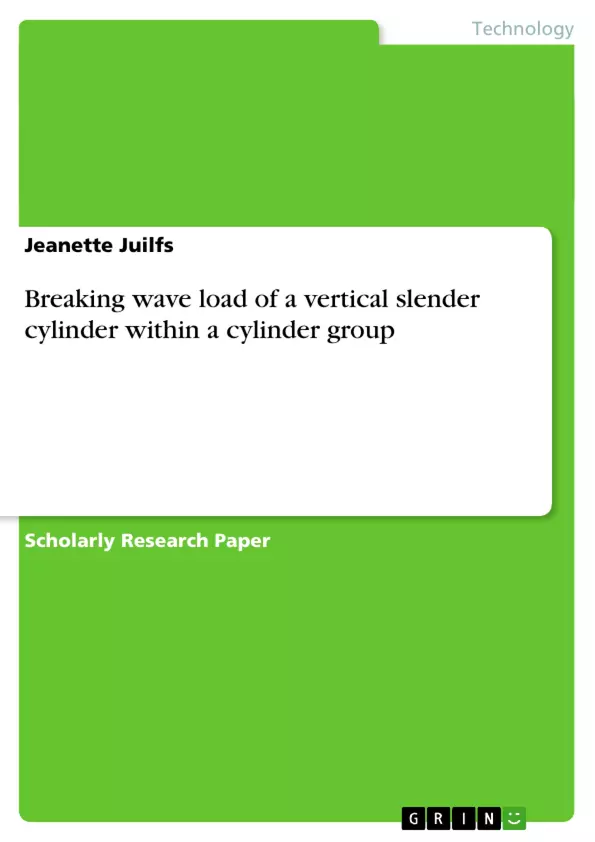Slender cylinders are widely used as a structural element in offshore structures. Oil platforms, jetties and piers are often supported by group of cylinders, which are arranged closely spaced. The Morison equation (Morison et al., 1950) constitutes a simple tool to calculate the wave force on one single cylinder. To what extent the cylinders, which are arranged in a group, affect each other is extensively unclear. As these group interference effects are not considered in the Morison equation there is a lack of a generally accepted formula to calculate the individual forces on cylinders within cylinder groups.
In this student research project the special loading case of breaking waves acting on cylinder groups is examined. Breaking waves developed from wave superposition during a storm may cause great impact loads also in deep water. The investigation of breaking waves leads to the upper bound of possible loads on offshore structures. A closer analysis of the so called impact force and the validation of former assumptions of considering it is not part of this paper. The main focus lies on the interactions between cylinders arranged in groups when a single breaking wave impinges the group or a part of it.
These interactions are investigated based on large-scale experiments, which have been performed in summer 2004 in the Large Wave Flume (GWK) at the Coastal Research Centre (FZK) in Hanover. Fifteen configurations of cylinder groups have been examined, including one configuration with one single cylinder and fourteen configurations of groups up to three cylinders arranged in row or transversely. The single cylinder and one cylinder in each cylinder group are equipped with strain gauges on the top, which measure the bending moments during the tests. These measuring cylinders, in the single arrangement and in the group arrangements, have the same position in the wave flume. Therefore the comparison of the measured bending moments of the single cylinder with those of the cylinder in the group provides information about the influence of the adjacent elements in a cylinder group. The results of the single cylinder test can be taken as a reference for the results of the cylinder group’s tests.
Inhaltsverzeichnis (Table of Contents)
- 1. Introduction
- 2. State of knowledge
- 2.1. Problem statement and procedure of analysing the state of knowledge
- 2.2. Flow around a cylinder
- 2.2.1. Steady flow
- 2.2.2. Oscillatory flow
- 2.3. Forces on a single cylinder
- 2.3.1. Drag force
- 2.3.2. Mass force
- 2.3.3. Drag and mass coefficient
- 2.4. Breaking waves
- 2.5. Single cylinder in breaking waves
- 2.6. Cylinder group
- 2.6.1. Tandem arrangement
- 2.6.2. Side by side arrangement
- 2.7. Experimental investigations with cylinder groups
- 2.8. Summary of existing results
- 3. Experimental investigation
- 3.1. Experimental set-up
- 3.2. Measuring instruments
- 3.3. Cylinder group configurations
- 3.4. Testing programme
- 4. Evaluation of the experimental results
- 4.1. Wave kinematics
- 4.1.1. Wave height
- 4.1.2. Wave celerity
- 4.1.3. Wave length
- 4.2. Total force on single cylinder
- 4.3. Total force on cylinder groups
- 4.3.1. Tandem arrangement
- 4.3.2. Side by side arrangement
- 4.1. Wave kinematics
- 5. Summary and concluding remarks
- 6. Acknowledgements
- 7. References
Zielsetzung und Themenschwerpunkte (Objectives and Key Themes)
This research project focuses on the breaking wave load of a vertical slender cylinder within a cylinder group. The objective is to analyze the impact of different cylinder group configurations on the forces experienced by individual cylinders within the group. The study aims to contribute to the understanding of breaking wave loads on slender cylinders in various arrangements, particularly in coastal engineering applications.
- Flow around a single cylinder and its interaction with breaking waves
- Forces experienced by a single cylinder in breaking waves
- Influence of different cylinder group configurations on breaking wave loads
- Experimental investigation of breaking wave loads on cylinder groups
- Analysis and evaluation of experimental results
Zusammenfassung der Kapitel (Chapter Summaries)
The first chapter provides an introduction to the topic of breaking wave load on slender cylinders within a cylinder group. It outlines the problem statement, the research objectives, and the methodology used in the study. The second chapter presents a comprehensive review of existing knowledge on the subject, covering topics such as flow around a cylinder, forces on a single cylinder in breaking waves, and the behavior of cylinder groups in wave environments.
The third chapter details the experimental investigation conducted for the study. It describes the experimental setup, the measuring instruments used, the various cylinder group configurations tested, and the testing programme. The fourth chapter focuses on the evaluation of experimental results, including analysis of wave kinematics, total force on single cylinders, and total force on cylinder groups. Finally, the fifth chapter provides a summary of the findings and concluding remarks.
Schlüsselwörter (Keywords)
Breaking wave load, slender cylinder, cylinder group, tandem arrangement, side by side arrangement, experimental investigation, wave kinematics, drag force, mass force, coastal engineering, structural stability.
- Quote paper
- Jeanette Juilfs (Author), 2006, Breaking wave load of a vertical slender cylinder within a cylinder group, Munich, GRIN Verlag, https://www.grin.com/document/61677



